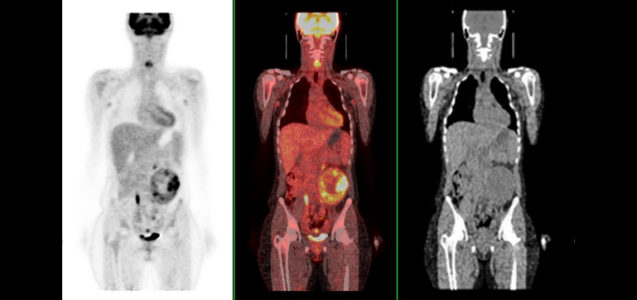

What is hybrid imaging and why do some Nuclear Medicine scanners have a CT scanner built-in? Since 2006, some of the Nuclear Medicine scanners at Cincinnati Children’s have a built in CT portion to the scanner. For many imaging studies, it has been shown that a combination of the functional information provided by Nuclear Medicine and the precise anatomic information provided by CT is particularly useful in diagnosis, especially in tumor diagnosis.
One example of hybrid imaging is a PET scan. We use a radioactive glucose because it is very valuable in locating tumors. Almost all tumors use more of the sugar glucose than adjacent normal tissues. Pictures that show concentrations of radioactive glucose aid physicians in finding tumors. The location of tumors is even more accurately determined when CT images and nuclear medicine images are obtained at the same time.
 Image: The image on the left is a PET scan, the image on the right is a CT scan and the image in the middle is a PET fused with a CT.
Image: The image on the left is a PET scan, the image on the right is a CT scan and the image in the middle is a PET fused with a CT.
The imaging study begins when the radioactive glucose (also called FDG) is injected into a vein. About one hour later, a precision nuclear medicine scanner called a PET scanner is used to make 3D pictures of the pattern of concentration of glucose in the body. As part of the same examination, a CT scan is performed with the patient in the exact same position in the scanner. The nuclear medicine and CT images can be then fused into a “hybrid” image, with the nuclear medicine images in color, overlaid on the CT images in black and white. In this way, the extremely sharp CT images are combined with the tumor-locating properties of the radioactive glucose, creating a particularly accurate method for locating tumor lesions called PET/CT.
Related article: Cincinnati Children’s Leads the Way In Nuclear Medicine Dose Reduction
In an earlier blog, we discussed the pioneering efforts to reduce radiation at Cincinnati Children’s to reduce the radiation dose to the patient during nuclear medicine imaging studies. Keeping the radiation dose as low as possible is also applied to the CT part of a PET/CT study. We have reduced radiation from PET/CT by designing special very low radiation CT scan techniques for PET/CT. Most PET/CT scans use a “localization CT” technique where the amount of radiation exposure is reduced 50 to 70% of the dose received during a standard diagnostic CT scan. When we are imaging bone, we can further reduce the amount of radiation exposure which is about 10% of a standard diagnostic CT scan. Limiting the amount of the body that is included in the CT scan will reduce the radiation dose even m ore. When we want to combine PET brain images with a sharper imagine, we combine the PET brain scan with a magnetic resonance scan of the brain obtained in an MRI scanner. The brain PET and the brain MRI scan are then fused using special “fusion” software, creating a PET/MRI scan.
Other hybrid nuclear medicine imaging techniques used at Cincinnati Children’s combine another type of scanner called a SPECT scanner that also contains a CT portion to it. SPECT/CT scans are performed with other radioactive imaging agents for scans of bone and lymph nodes. SPECT/CT scans are also used with radioactive iodine in diagnosis of thyroid and adrenal cancers.
Contributed by Dr. Michael Gelfand and edited by Bessie Ganim, (Spec Tech-Nuc Med).
